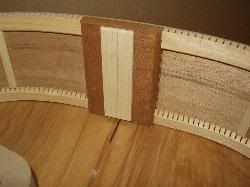Page 1 of 2
Depth of the tailblock
Posted: Mon Sep 06, 2010 3:30 pm
by Herman
Is there a reason why the tailblock could not be as deep as the top of the kerfing is?
In other words: Does it have to be such a massive block?
(One I can think of is that the structure should hold the guitar to the strapbutton, but if you don't have one?)
Any thoughts?
Herman
Re: Depth of the tailblock
Posted: Mon Sep 06, 2010 4:30 pm
by kencierp
Years ago I built many "D" size guitars using David Russel Young's specs (except for the wierd neck butt joint) those instrument have 3/8" x 2 1/2" x depth --- tail blocks ---- no problems.
Re: Depth of the tailblock
Posted: Mon Sep 06, 2010 8:25 pm
by kencierp
Tom Ribbecke holds a patent and has built guitars an with access hole and door instead of a tail block -- I suppose the idea was to get inside and shave braces after the guitar was completed -- kind of a cool idea. Purhaps a thinner block will allow a square inch or more so sound-board to vibrate?? My blocks are fairly thick, I run the grain horizontal for easy contouring --- but there is also a 1" vertical spruce reinforcement. The total thickness still allows the installation of an end pin jack/preamp etc.
Re: Depth of the tailblock
Posted: Mon Sep 06, 2010 9:08 pm
by Darryl Young
One thing to consider is that the weight in the tail block helps balance the weight of the neck.......at least this is where you get the most benefit from adding weight and the most impact from subtracting weight as it is the furthest point from the neck. It's crossed my mind to use a denser tail block to balance the guitar better.
On my current build I angled the top/bottom/sides of the tail block leaving the edge of the top/back the same thickness as the lining. My thought is this would free up the top and back a little and I didn't want the shape of the tail block to add an odd shape to the vibration modes of the top. Now there is a smooth smooth gluing surface along the entire perimeter of the lower bout.
Re: Depth of the tailblock
Posted: Tue Sep 07, 2010 7:14 am
by tippie53
on my guitars , I inlay a piece of plywood that will set against the sides , for the reason Rick mentioned. Having seen more than my share of exploded guitars from being dropped , the plywood stops the tail block from splitting. You can build any way that you want to but thing of the possible things that can happen. These are fragile instruments and this piece will help should you knock it about.
You don't need a piece of 2 by 4 but something in the range of 5/8 inch will do the trick
Re: Depth of the tailblock
Posted: Tue Sep 07, 2010 7:59 am
by kencierp
This is my current design -- the reinforment and the wedge should hold things together well

Re: Depth of the tailblock
Posted: Tue Sep 07, 2010 11:07 am
by JJDonohue
kencierp wrote:This is my current design -- the reinforment and the wedge should hold things together well

Ken...From your pic, I was curious as to why you glue in your kerfed liners differently for each side...one has the kerfs facing inside...the other facing outside.
I use 1/2" Baltic Birch plywood for my tail blocks as John described. I also mill in a flange on the ends such that the gluing surface of the tail block is the same width as that of the kerfed liner. It eliminates the possibility of the dreaded ghosting image of a wider block on the completed guitar.
Re: Depth of the tailblock
Posted: Tue Sep 07, 2010 11:14 am
by tippie53
JJ flip the ply so it is against the sides . The wedge in a strap pin can still pop that tail block. I played with that and you can acutally drive the pin into the plywood to the point is smashes , it never popped the tail block . when I tried it that way I did split the block but not as bad.
Re: Depth of the tailblock
Posted: Tue Sep 07, 2010 11:16 am
by kencierp
JJ
Reverse rounded kerfing --- rounded edge inboard top and back -- Not sure what you are asking??
Re: Depth of the tailblock
Posted: Tue Sep 07, 2010 1:50 pm
by Herman
Runningdog, I tell you why I did ask:
I make my tailblock about 3/4" deep. For sanding the sides I use a 28' radius disk. Still I have a few guitars that bulge a bit behind the bridge and after a couple of years, when the light reflex over the top, I can see an imprint of the tailblock. (Maybe I did use too much clamping pressure).
With a tailblock as deep as the kerfing no imprint will ever occur.
But I like Darryl's solution by making the top and bottom of the block angled. And it would keep the block strong as John promotes.
Thanks for answering guys.
Herman
